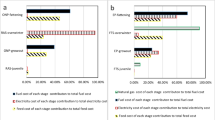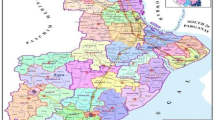Abstract
Recirculating aquaculture system (RAS) is a unique approach that offers total control to culture a wide variety of aquatic species. As capital investment is higher for setting up RAS, it is necessary to conduct an economic feasibility analysis based on real data. A structured questionnaire was used to collect all economic and technical data on two catfish species, viz., Pabda (Ompok pabda) and Shing (Heteropneustes fossilis), cultured in an RAS farm. The ultimate objective was to estimate net cash flow, net present value (NPV), profitability index (PI), payback period, discounted payback period, internal rate of return (IRR), and sensitivity analysis to find out the best profitability indicators. The analysis revealed that the IRR were 4% and 16% for Pabda and Shing production, respectively. However, for Pabda and Shing productions, the payback periods were 15 years and 4 months and 6 years and 2 months, respectively. The NPV value was positive for Shing production and negative for Pabda. On the other hand, the PI was lower than one for Pabda production and higher than one for Shing production. Therefore, the results showed that the Shing production in the RAS facility could be economically feasible; however, Pabda production may not be viable in RAS due to lower production and longer culture period. This study may suggest that by increasing the production capacity of the farm and market price of the product through the proper supply chain and by decreasing the initial investment, cost of fingerlings and feed, profitability can be achieved in RAS in Bangladesh.





Similar content being viewed by others
References
Ahmad R (2017) Indoor farming: novel way to up fish yield. The Daily Star, Bangladesh. (https://www.thedailystar.net/frontpage/indoor-farming-novel-way-fish-yield-1358101, accessed on 14 August, 2021)
Ali SA (2012) A techno-financial analysis of tilapia production in the recirculating aquaculture systems. Misr J Agric Eng 29(4):1583–1602. https://doi.org/10.21608/mjae.2012.101383
Appiah-Kubi F (2012) An economic analysis of the use of recirculating aquaculture systems in the production of Tilapia [master’s thesis]. Department of Animal and Aquaculture Sciences. Norwegian University of Life Sciences, Norway
Belton B, Karim M, Thilsted S, Murshed-E-Jahan K, Collis W, Phillips M (2011) Review of aquaculture and fish consumption in Bangladesh. Studies and Reviews 2011-53. The WorldFish Center
Bostock J, Lane A, Hough C, Yamamoto K (2016) An assessment of the economic contribution of EU aquaculture production and the influence of policies for its sustainable development. Aquacult Int 24(3):699–733. https://doi.org/10.1007/s10499-016-9992-1
Boulet D, Struthers A, Gilbert E (2010) Feasibility study of closed-containment options for the British Columbia Aquaculture Industry. Fisheries and Oceans Canada
Bregnballe J (2015) A guide to recirculation aquaculture: an introduction to the new environmentally friendly and highly productive closed fish farming systems (2015 ed.). The Food and Agriculture Organization of the United Nations (FAO) and Eurofish International Organization. Retrieved from http://www.fao.org/3/a-i4626e.pdf. Accessed 18 Jul 2020
De Ionno PN, Wines GL, Jones PL, Collins RO (2006) A bioeconomic evaluation of a commercial scale recirculating finfish growout system: an Australian perspective. Aquaculture 259(1):315–327. https://doi.org/10.1016/j.aquaculture.2006.05.047
Del Campo LM, Ibarra P, Gutiérrez X, Takle H (2010) Utilization of sludge from recirculation aquaculture systems. Nofima, Norway
Ebeling J, Jensen G, Losordo T, Masser M, McMullen J, Pfeiffer L, Sette M (1995) Model aquaculture recirculation system (MARS): engineering and operations manual: aquaculture education project. Department of Agricultural Education and Studies. Iowa State University, USA
Einen O, Roem AJ (1997) Dietary protein/energy ratios for Atlantic salmon in relation to fish size: growth, feed utilization and slaughter quality. Aquacult Nutr 3(2):115–126. https://doi.org/10.1046/j.1365-2095.1997.00084.x
Engle CR, Kumar G, van Senten J (2020) Cost drivers and profitability of U.S. ponds, raceways, and RAS aquaculture. JWorld Aquacult Soc 2020:1–27. https://doi.org/10.1111/jwas.12706
Fern M (2014) An economic comparison of three intensive fish production systems [master’s thesis]. Aquaculture and Aquatic Sciences, Auburn University, School of Fisheries
Food and Agriculture Organization (2006) State of world aquaculture (Tech. paper no. 500). Rome, Italy
Food and Agriculture Organization (2018) The state of world fisheries and aquaculture 2018: meeting the sustainable development goals. Rome, Italy
Food and Agriculture Organization (2020) The state of world fisheries and aquaculture 2020: sustainability in action. Rome. https://doi.org/10.4060/ca9229en
Godfray HC, Beddington JR, Crute IR, Haddad L, Lawrence D, Muir JF, Toulmin C (2010) Food security: the challenge of feeding 9 billion people. Science 327(5967):812–818. https://doi.org/10.1126/science.1185383
Head WD, Watanabe WO (1995) Economic analysis of a commercial scale, recirculating, brackish water hatchery for Florida Red Tilapia. J Appl Aquacult 5(2):1–23. https://doi.org/10.1300/J028v05n02_01
Hoff KG (1998) Cost performance volume analysis. In: Hoff KG (ed) Basic Business Management. Tano Aschehoug, AiTEnger AS, Otta, Norway, pp 379–403
Islam MR, Hassan MZ (2011) Land use changing pattern and challenges for agricultural land: a study on Rajshahi District. J Life Earth Sci 6:69–74. https://doi.org/10.3329/jles.v6i0.9724
Kazmierczak R, Caffey R (1995) Management ability and the economics of recirculating aquaculture production systems. Mar Resour Econ 10(2):187–209 Retrieved from www.jstor.org/stable/42629110. Accessed 18 Jul 2020
Larson KD, Wild JJ, Chiappetta B (2002) Fundamental accounting principles (16th ed). McGraw-Hill Irwin Publishing, USA
Lazur AM, Goldman J, Semmens KJ, Timmons MB (2003) Land-based aquaculture production systems, engineering, and technology: opportunities and needs. Northeastern Regional Aquaculture Center. Publication No. 03-002. 17 pp.
Losordo TM, Westerman PW (1994) An analysis of biological, economic and engineering factors affecting the cost of fish production in recirculating aquaculture systems. J World Aquacult Soc 25(2):193–203. https://doi.org/10.1111/j.1749-7345.1994.tb00181.x
Martins CIM, Eding EH, Verdegem MCJ, Heinsbroek LTN, Schneider O, Blancheton JP, Rogue d’Orbcastel E, Verreth JAJ (2010) New developments in recirculating aquaculture systems in Europe: a perspective on environmental sustainability. Aquacult Eng 43(3):83–93. https://doi.org/10.1016/j.aquaeng.2010.09.002
Mohammad T, Moulick S, Mukherjee CK (2018) Economic feasibility of goldfish (Carassius auratus Linn.) recirculating aquaculture system. Aquacult Res 49(9):2945–2953. https://doi.org/10.1111/are.13750
Murray F, Bostock J, Fletcher D (2014) Review of recirculation aquaculture system technologies and their commercial application. University of Stirling Aquaculture, Highlands and Islands Enterprise
NCRAC (2002) Tilapia report. https://www.ncrac.org/files/project/files/tilapiareport2_0.pdf. Accessed on 10 July 2020
Ngoc PTA, Meuwissen MP, Cong Tru L, Bosma RH, Verreth J, Lansink AO (2016) Economic feasibility of recirculating aquaculture systems in pangasius farming. Aquacult Econ Manag 20(2):185–200. https://doi.org/10.1080/13657305.2016.1156190
O’Rourke PD (1991) Current status on profits in recirculating systems, In: Regional Workshop on Commercial Fish Culture Using Water Recirculating Systems. IL-IN-SG-E-91-8. Illinois/Indiana Sea Grant, Illinois State University, Normal, Illinois, pp 65-99
O’Rourke PD (1996) The economics of recirculating aquaculture systems. In: Successes and failures in commercial re-circulating aquaculture. Proceedings of an international workshop, Roanoke, Virginia, VA, USA, pp 61–78
Pereira DAS, Henriques MB (2019) Economic feasibility for producing Imperial Zebra pleco (Hypancistrus zebra) in recirculating aquaculture systems: an alternative for a critically endangered ornamental fish. Aquacult. Econ. Manag. 23(4):428–448. https://doi.org/10.1080/13657305.2019.1641574
Petty JW, Peacock R, Martin P, Burrow M, Keown AJ, Scott DF, Martin JD (1996) Basic financial management. Prentice Hall Publishing, Sydney, Australia
Rawlinson P (2002) The economic efficiencies of partial and intensive recirculation aquaculture systems for Murray cod. In: Ingram BA (ed) Murray Cod Aquaculture: Now and into the Future Victorian Institute of Animal Science. Attwood, Victoria, Australia, pp 17–18
Schneider O, Blancheton JP, Varadi L, Eding EH, Verreth JAJ (2006) Cost price and production strategies in European recirculation systems. In:Conference Aqua 2006: Linking Tradition & Technology Highest Quality for the Consumer, Firenze (Florence), Italy, 9-13 May 2006, pp 855
Shang YC (1990) Aquaculture economic analysis: an introduction. World Aquaculture Society
Terjesen BF, Ulgenes Y, Færa SO, Summerfelt ST, Brunsvik P, Baeverfjord G, Nerland S, Takle H, Norvik OC, Kittelsen A (2008) RAS research facility dimensioning and design: a special case compared to planning production systems. In: Aquaculture Engineering Society Issues Forum Proceedings, Roanoke, Virginia, 23–24 July, pp 223–238
Timmons MB, Ebeling JB (2013) Recirculating aquaculture, 3rd edn. Ithaca Publishing Company, LLC
Wright A, Arianpoo N (2010) Technologies for viable salmon aquaculture: an examination of land-based closed containment aquaculture: a public domain report. SOS Marine Conservation Foundation
Availability of data and material
All relevant data are included in the manuscript and in supplementary materials.
Code availability
Not applicable.
Funding
This work was partially supported by the University Grants Commission of Bangladesh through the University of Dhaka for the financial year 2018–2019; Arifa received the National Science and Technology (NST) fellowship of Bangladesh as an MS research student.
Author information
Authors and Affiliations
Contributions
Arifa: investigation, data curation, formal analysis, writing – original draft preparation. Mst Khadiza Begum: data curation, formal analysis, writing – original draft preparation. Raad Mozib Lalon: formal analysis, writing – reviewing and editing. ABM Shamsul Alam: investigation, resources, writing – reviewing and editing. Mohammad Shamsur Rahman: conceptualization, methodology, resources, supervision, writing – reviewing and editing.
Corresponding author
Ethics declarations
Ethics approval
Not applicable.
Consent to participate
Not applicable.
Consent for publication
Not applicable.
Competing interests
The authors declare no competing interests.
Additional information
Handling Editor: Gavin Burnell
Publisher’s note
Springer Nature remains neutral with regard to jurisdictional claims in published maps and institutional affiliations.
Rights and permissions
About this article
Cite this article
Arifa, Begum, M.K., Lalon, R.M. et al. Economic feasibility of Pabda and stinging catfish culture in recirculating aquaculture systems (RAS) in Bangladesh. Aquacult Int 30, 445–465 (2022). https://doi.org/10.1007/s10499-021-00807-1
Received:
Accepted:
Published:
Issue Date:
DOI: https://doi.org/10.1007/s10499-021-00807-1




